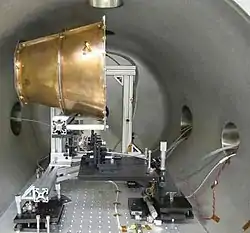Helical engine
The Helical engine is a proposed spacecraft propulsion drive that could possibly exploit the known mass-altering effects that occur at near the speed of light. The concept was proposed by David M. Burns, a NASA engineer at the Marshall Space Flight Center in Alabama. He wrote a paper published by NASA in 2019 describing it as "A new concept for in-space propulsion is proposed in which propellant is not ejected from the engine, but instead is captured to create a nearly infinite specific impulse".[1][2]

EmDrive, another type of reactionless drive
Burns points out that, despite the concept is inefficient, there is a possibility in harvesting the energy that the accelerator loses in heat and radiation, as well as conserving the momentum in the spin of the accelerated ions.[3][4]
References
- "NASA Technical Reports Server (NTRS)" (PDF). ntrs.nasa.gov. Retrieved 2020-12-05.
- Siegel, Ethan. "For The Last Time, No, A NASA Engineer Has Not Broken Physics With An Impossible Engine". Forbes. Retrieved 2020-12-05.
- Cartwright, Jon. "NASA engineer's 'helical engine' may violate the laws of physics". New Scientist. Retrieved 2020-12-05.
- Koberlein, Brian (2019-10-16). "NASA Engineer Has A Great Idea for a High-Speed Spacedrive. Too Bad it Violates the Laws of Physics". Universe Today. Retrieved 2020-12-05.
This article is issued from Wikipedia. The text is licensed under Creative Commons - Attribution - Sharealike. Additional terms may apply for the media files.